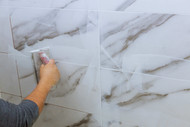Grout for Backsplash: Your Key to a Stunning Kitchen
Posted by Mike Belk on Dec 04, 2023

The Power of Backsplash
A well-designed backsplash has the power to transform your kitchen into a stunning space. Not only does it enhance the overall aesthetic appeal, but it also serves a functional purpose. Let's explore how a backsplash can elevate your kitchen and the crucial role that grout plays in its design.
Enhancing Your Kitchen with Backsplash
A backsplash is a vertical surface that protects the walls behind your kitchen countertops and stove from splashes, stains, and moisture. However, it offers more than just practical benefits. It provides an opportunity to express your style and add visual interest to your kitchen.
With a vast array of materials, colors, and patterns available, you can choose a backsplash that complements your kitchen's theme and reflects your personal taste. Whether you opt for classic subway tiles, sleek glass mosaics, or intricate patterned designs, a well-chosen backsplash can become the focal point of your kitchen, tying the entire look together.
The Role of Grout in Backsplash Design
While the tiles themselves contribute to the beauty of a backsplash, the grout that fills the gaps between them plays a crucial role in the overall design. Grout not only provides structural support but also enhances the visual impact of the tiles.
Grout acts as a cohesive element, highlighting the individual tiles and creating a seamless appearance. It can either blend in with the tiles, creating a subtle and uniform look, or contrast with them, making a bold statement. The color and width of the grout lines can dramatically impact the aesthetic appeal of the backsplash.
To choose the right grout for your backsplash, consider factors such as the color and material of the tiles, the desired style, and the level of maintenance you're willing to undertake. For instance, if you're installing a glass tile backsplash, you may want to explore different grout colors that complement or provide contrast to the tiles. Our article on grout color for glass tile backsplash can provide further guidance.
Additionally, it's important to select a grout that is durable and stain-resistant, ensuring your backsplash remains in pristine condition for years to come. Properly sealing the grout can also enhance its longevity and protect it from moisture and stains. For more information on grout sealers, refer to our article on grout sealer for backsplash.
By understanding the power of backsplash and the role of grout in its design, you can create a kitchen that not only functions efficiently but also captivates with its aesthetic appeal. Explore different grout options, consider the style and maintenance requirements, and let your creativity shine as you design the perfect backsplash for your kitchen.
Understanding Grout for Backsplash
When it comes to backsplash design, grout plays a crucial role in both the aesthetic appeal and functionality of the installation. Understanding what grout is and the importance of choosing the right grout is essential for achieving a stunning kitchen backsplash.

What is Grout?
Grout is a paste-like material that is used to fill the gaps between tiles in a backsplash. It is typically made from a mixture of cement, water, and sometimes sand. Grout serves two main purposes: to provide structural support by holding the tiles in place and to create a cohesive, finished look.
Grout comes in different types, each offering unique characteristics and benefits. The choice of grout will depend on factors such as the type of tiles used, the desired style, and the level of maintenance required.
Importance of Choosing the Right Grout
Selecting the right grout is crucial for achieving the desired look and ensuring the longevity of your backsplash. Here are a few reasons why choosing the right grout is important:
- Aesthetics: The color and texture of the grout can greatly impact the overall appearance of your backsplash. It can complement or contrast with the tiles, allowing you to achieve the desired design aesthetic. For more information on selecting the right grout color, check out our article on grout color for glass tile backsplash.
- Durability: The type of grout you choose will affect the durability and lifespan of your backsplash. Factors such as moisture resistance, stain resistance, and crack resistance should be considered when selecting the grout. Different grout types offer varying levels of durability, so it's important to choose one that suits your specific needs.
- Maintenance: The ease of maintenance is another important consideration. Some grouts may require more frequent sealing or cleaning to keep them looking their best. It's important to assess your willingness and ability to maintain the grout regularly. For more information on grout maintenance, you can check out our article on grout sealer for backsplash.
By understanding what grout is and the importance of choosing the right grout, you can make informed decisions when it comes to your kitchen backsplash. Consider factors such as aesthetics, durability, and maintenance requirements when selecting the grout for your project. For more guidance on how to choose grout for backsplash, refer to our article on how to choose grout for backsplash.
Types of Grout
When it comes to selecting the right grout for your backsplash, it's important to consider the different types available and their unique characteristics. The type of grout you choose can impact both the aesthetic appeal and the durability of your backsplash. Let's explore three common types of grout: cement-based grout, epoxy grout, and urethane grout.
Cement-Based Grout
Cement-based grout is a widely used and versatile option for backsplashes. It consists of a mixture of cement, sand, and water. Cement-based grout offers several advantages, including affordability, ease of application, and a wide range of color options. This type of grout is suitable for most backsplash materials, including ceramic, porcelain, and natural stone.
However, it's important to note that cement-based grout is porous, meaning it can absorb moisture and stains over time. To protect your cement-based grout and enhance its longevity, it is recommended to apply a grout sealer. For more information on grout sealers, check out our article on grout sealer for backsplash.
Epoxy Grout
Epoxy grout is a popular choice for backsplashes due to its exceptional durability and stain resistance. This type of grout is made from a combination of epoxy resins and a hardener. Epoxy grout is highly resistant to water, chemicals, and stains, making it an excellent option for areas prone to moisture, such as kitchens and bathrooms.
In addition to its durability, epoxy grout offers a wide range of color options and is less prone to cracking and fading over time. However, epoxy grout can be more challenging to work with and requires careful mixing and application. It is recommended to follow the manufacturer's instructions to ensure proper use. For more information on using epoxy grout for your backsplash, visit our article on epoxy grout for backsplash.
Urethane Grout
Urethane grout is a relatively newer option that combines the best qualities of cement-based and epoxy grouts. This grout is made from a combination of urethane polymers, pigments, and fillers. Urethane grout offers excellent stain resistance, durability, and color consistency.
One of the key advantages of urethane grout is its flexibility. It is less prone to cracking and shrinking, making it suitable for backsplashes that may experience slight movement or vibration. Urethane grout is also resistant to mold and mildew growth, making it ideal for high-moisture areas. However, urethane grout can be more expensive compared to other types of grout.
When choosing the right grout for your backsplash, consider factors such as material compatibility, desired durability, and maintenance requirements. For more guidance on selecting the best grout for your specific backsplash needs, refer to our article on how to choose grout for backsplash.
By understanding the characteristics of cement-based grout, epoxy grout, and urethane grout, you can make an informed decision that will not only enhance the aesthetic appeal of your backsplash but also ensure its long-term durability.
Factors to Consider
When it comes to choosing grout for your backsplash, there are several important factors to consider. The color selection, grout width, and maintenance and durability of the grout all play a significant role in achieving the desired look and functionality for your kitchen.
Color Selection
Selecting the right grout color is crucial in achieving the desired aesthetic for your backsplash. The color of the grout can either blend in with the tiles or create a contrasting effect, depending on your preference. It's important to consider the overall color scheme and style of your kitchen when choosing the grout color.
| Grout Color | Effect |
| White | Creates a clean and seamless look. |
| Gray | Provides a subtle contrast and complements a variety of tile colors. |
| Beige | Offers a warm and natural look. |
| Colored | Adds a pop of color and creates a bold statement. |
For more information on choosing the right grout color for your glass tile backsplash, check out our article on grout color for glass tile backsplash.
Grout Width
The width of the grout lines can significantly impact the overall appearance of your backsplash. The general rule of thumb is that larger tiles typically look better with wider grout lines, while smaller tiles benefit from narrower grout lines. However, personal preference and the style you want to achieve also come into play.
| Tile Size | Recommended Grout Width |
| Large tiles (12" x 12" or larger) | 1/8" - 3/16" |
| Medium tiles (6" x 6" to 12" x 12") | 1/16" - 1/8" |
| Small tiles (less than 6" x 6") | 1/16" or less |
Keep in mind that wider grout lines may require more maintenance and cleaning, as they are more prone to staining and accumulation of dirt. Narrower grout lines, on the other hand, can be more challenging to clean due to their small size. Consider your personal preference and the level of maintenance you are willing to undertake when choosing the grout width.
Maintenance and Durability
The maintenance and durability of the grout are essential factors to consider, especially in high-traffic areas such as the kitchen. Different types of grout have varying levels of maintenance requirements and durability.
| Grout Type | Maintenance | Durability |
| Cement-Based Grout | Requires regular sealing and occasional cleaning. | Moderately durable and can last for several years. |
| Epoxy Grout | Low maintenance and resistant to stains and discoloration. | Highly durable and suitable for areas prone to moisture and heavy use. |
| Urethane Grout | Low maintenance and stain-resistant. | Extremely durable and resistant to cracking and fading. |
To ensure the longevity of your grout and protect it from stains and discoloration, it's important to apply a grout sealer. For more information on grout maintenance and selecting the best grout for your backsplash, refer to our article on how to choose grout for backsplash.
By considering these factors - color selection, grout width, and maintenance and durability - you can make an informed decision when choosing the grout for your backsplash. Remember to take into account your personal style preferences, the tile size, and the level of maintenance you are comfortable with. This will ensure that your kitchen backsplash not only looks stunning but also stands the test of time.
Tips for Grouting Your Backsplash
Grouting your backsplash is a crucial step in the installation process that can greatly impact the final look of your kitchen. Follow these tips to ensure a successful and beautiful grouting experience.
Preparing the Surface
Before you begin grouting, it's important to properly prepare the surface of your backsplash. Here are some key steps to take:
- Clean the tiles: Ensure that the tiles are clean and free from any dirt, dust, or adhesive residue. Use a mild cleaning solution and a soft cloth or sponge to gently wipe down the tiles.
- Protect adjacent surfaces: To prevent the grout from staining or damaging nearby surfaces, such as countertops or cabinets, apply painter's tape or plastic sheeting to protect them.
- Wet the tiles: Before applying the grout, dampen the tiles with water. This helps to prevent the grout from drying out too quickly and makes it easier to work with.
Mixing and Applying Grout
Once the surface is prepared, it's time to mix and apply the grout. Follow these steps for successful grout application:
- Read the manufacturer's instructions: Different grout products may have specific mixing and application instructions. Be sure to read and follow the guidelines provided by the manufacturer.
- Mix the grout: Use a clean bucket or container to mix the grout according to the instructions. Ensure that the grout is thoroughly mixed and has a smooth, paste-like consistency.
- Apply the grout: Use a grout float or a rubber grout applicator to spread the grout over the tiles at a 45-degree angle. Work in small sections to prevent the grout from drying out before you can complete the entire backsplash.
- Fill the gaps: Press the grout firmly into the gaps between the tiles, ensuring that each joint is completely filled. Use the float or applicator to remove any excess grout from the tile surfaces.
- Wipe off excess grout: After about 15-20 minutes, once the grout begins to dry, use a damp sponge or cloth to gently wipe off any excess grout from the tile surfaces. Rinse the sponge frequently to ensure a clean wipe.
Cleaning and Sealing the Grout
Properly cleaning and sealing the grout is essential for maintaining its appearance and durability. Follow these steps for effective grout cleaning and sealing:
- Wait for the grout to cure: Allow the grout to dry and cure for the recommended time specified by the manufacturer. This can typically range from 24 to 72 hours.
- Clean the grout lines: Once the grout is fully cured, use a grout cleaner and a grout brush to scrub the grout lines and remove any haze or residue. Rinse the tiles thoroughly with clean water.
- Apply grout sealer: To protect the grout from stains and moisture, apply a grout sealer according to the manufacturer's instructions. Use a small brush or applicator to evenly distribute the sealer over the grout lines. Be sure to also seal any vertical or exposed edges.
By following these tips, you can achieve a well-executed grouting process that enhances the overall look of your backsplash. Remember to choose the right grout color and type based on your specific tile and design preferences. For more information on how to choose the perfect grout for your backsplash, check out our article on how to choose grout for backsplash.



